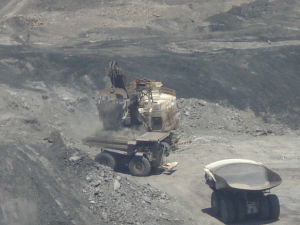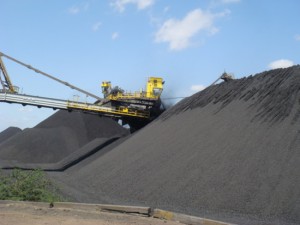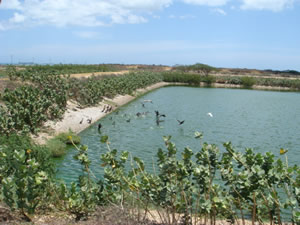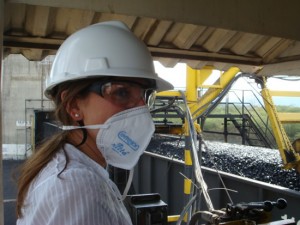« The Green Protocol | Home | From Banners to Reusable Shopping Bags »
Inspecting the World’s Largest Open Pit Coal Mine
By Keith R | September 6, 2008
Topics: Energy & the Environment, Environmental Protection, Extractive Sectors | No Comments »
 Recently Colombia’s Vice Minister for the Environment, Claudia Mora Pineda, the Ministry’s director of licenses and permits, and the head of the National Natural Parks Unit (UPNN) paid an “inspection” visit to El Cerrejón, Colombia’s largest coal mine and probably the largest open pit coal mine in the world. They also visited the mining firm’s port loading facility in Portete Bay.
Recently Colombia’s Vice Minister for the Environment, Claudia Mora Pineda, the Ministry’s director of licenses and permits, and the head of the National Natural Parks Unit (UPNN) paid an “inspection” visit to El Cerrejón, Colombia’s largest coal mine and probably the largest open pit coal mine in the world. They also visited the mining firm’s port loading facility in Portete Bay.
Why do I utilize quotation marks around the word inspection? Well, because I have some doubts about it being a true inspection instead of a photo opportunity or a high-visibility “message” visit. True, down-to-brass-tacks environmental inspections are usually not conducted by top Ministry appointees with cameras in tow. And there certainly is no indication that the visit caught mine officials by surprise.
 So what then was this visit? I suspect that it had a dual purpose, neither of which to do an in-depth inspection the El Cerrejón facilities.
So what then was this visit? I suspect that it had a dual purpose, neither of which to do an in-depth inspection the El Cerrejón facilities.
The first was to send a message to industry. By using top officials, the Ministry appears to be signaling to industry that it intends to be high profile about inspections. That might be useful, as long as it is followed up by systematic, targeted, technically sound inspection work by regular inspectors and not by many more showboat visits. Too many of the latter and the Ministry will run the risk of being viewed as all show, no substance.
 The second purpose was to showcase and praise improvements at El Cerrejón. By most accounts, the mine and port facility were never that bad environmentally — at least as far as mines go. But they were asked to improve and have worked to do so in recent years, getting ISO 14001 certification, recycling wastes, recycling water used in the oxidation lagoons, initiating a fauna rescue and rehabilitation program, recovering lands, and enlisting the aid of the Inter-American Development Bank (IDB) to identify ways to reduce greenhouse gas emissions associated with its mining and port operations.
The second purpose was to showcase and praise improvements at El Cerrejón. By most accounts, the mine and port facility were never that bad environmentally — at least as far as mines go. But they were asked to improve and have worked to do so in recent years, getting ISO 14001 certification, recycling wastes, recycling water used in the oxidation lagoons, initiating a fauna rescue and rehabilitation program, recovering lands, and enlisting the aid of the Inter-American Development Bank (IDB) to identify ways to reduce greenhouse gas emissions associated with its mining and port operations.
Although they may still have room for improvement, their operations are better managed environmentally than other coal mining operations in Colombia. That may be the point, then: high-level praise for them as a model for others to emulate.
________________________
 Desde el Ministerio de Ambiente, Vivienda y Desarrollo Territorial (MAVDT):
Desde el Ministerio de Ambiente, Vivienda y Desarrollo Territorial (MAVDT):
Viceministra de ambiente visitó complejo carbonífero para revisar cumplimiento de normativa ambiental
La viceministra de Ambiente, Claudia Mora Pineda, la directora de la Unidad de Parques Nacionales Naturales de Colombia, Julia Miranda y la directora de Licencias permisos y Trámites Ambientales, Diana Zapata, realizaron una visita de inspección al complejo carbonífero de El Cerrejón para revisar el manejo ambiental en relación con su puerto de embarque en bahía Portete y todo lo asociado a la operación minera.
“Cerca del 40% de la operación nacional de carbón la maneja El Cerrejón, una Compañía que ha demostrado logros significativos en materia de responsabilidad ambiental”, sostuvo la Viceministra Mora Pineda, quien resaltó la gestión realizada por la compañía.
El recorrido comenzó en las instalaciones del puerto de embarque, en donde se observaron las operaciones y medidas de manejo ambiental correspondientes a las instalaciones de descargue de trenes carboneros, los patios de acopio y mezclas, las bandas de transporte y el mecanismo de cargue directo a los barcos.
La visita abarcó la planta de lavado de carbones, el parque de almacenamiento y el cargue de trenes, donde se observaron las medidas implementadas para mitigar los impactos que se puedan ocasionar durante el transporte del mineral procesado.
Tags: Bahía Portete, barcos, BID, carbón, coal, Colombia, El Cerrejón, environment, gases de efecto invernadero, greenhouse gases, IDB, inspección ambiental, ISO 14001, MAVDT, medio ambiente, minería, mining, open pit mines, oxidation lagoons, reciclaje, recycling, responsabilidad ambiental, wastes


